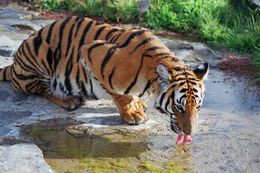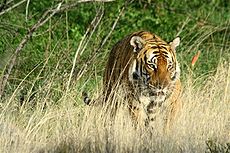South China Tiger
| South China Tiger simplified Chinese: 华南虎 traditional Chinese: 華南虎 |
|
|---|---|
 |
|
| Conservation status | |
| Scientific classification | |
| Kingdom: | Animalia |
| Phylum: | Chordata |
| Class: | Mammalia |
| Order: | Carnivora |
| Family: | Felidae |
| Genus: | Panthera |
| Species: | P. tigris |
| Subspecies: | P. t. amoyensis |
| Trinomial name | |
| Panthera tigris amoyensis (Hilzheimer, 1905) |
|
 |
|
| South China tiger range | |
The South China tiger or South Chinese tiger (Panthera tigris amoyensis), also known as the Chinese, Amoy, or Xiamen tiger, is a subspecies of tiger native to the forests of Southern China. The South China tiger is one of the smaller and it is the most critically endangered of any of the living tiger subspecies. Experts maintain that there are fewer than 20 of these tigers left in the wild, and warn that it might become extinct within the next decade. One was recently born in a reserve in South Africa in November 2007, the first to be born outside China.[2] In October 2007, the forestry department of Zhenping county, Shaanxi published photographs of P. t. amoyensis in its native habitat, but these were later debunked after an investigation.[3] The South China tiger is considered to be the “stem” tiger, the subspecies from which all other tigers descended.[4] The South China tiger has been recently listed as one of the world's 10 most endangered animals.[5]
Contents |
Physical characteristics
The South China tiger is one of the smallest tiger subspecies. Male tigers measure about 2.6 m (8 ft) from head to tail and weigh about 150 kg (330 lb). Female tigers are smaller, measuring about 2.3 m (7 1/2 ft) long. They weigh approximately 110 kg (240 lbs). The short, broad stripes of the South China tiger are spaced far apart compared to those of Bengal and Amur tigers.[6]
Diet
The South China tiger, like all other subspecies of tigers, are pure carnivores. The South China tiger prefers prey ranging between 30-400 lbs and have been known to eat livestock like cows and goats in the past when their population was much higher. They are expert hunters and will stalk and follow their prey for hours. South China tigers have an average speed of around 35mph, faster than most of its prey species, but they do not have enough stamina to maintain their top speed for long. These big cats kill their prey with a bite to the back of its neck (usually for medium-sized)
Habitat
The South China tiger, Panthera tigris amoyensis, was formerly abundant in South China's temperate upland forests. Today its wide range has been reduced to three isolated areas in south-central China, where small and scattered populations are said to persist along the mountainous borders between provinces. As with the Black-footed Ferret, one of the biggest contributing factors to the South China tigers' dwindling population is the destruction of its prey base. Two other major factors that have contributed to the tiger’s decline are poaching and population fragmentation. South China tigers, like other tiger subspecies, live in dense jungles. South China tigers also love spending time in water, similar to other tiger subspecies.

Persecution and extinction
Until the beginning of the 20th century, the South China tiger was distributed in southern China and Hong Kong. The last known contact in Hong Kong was reported in 1947. In 1959, Mao Zedong, in the time of the Great Leap Forward, declared the tiger and other predators such as leopards and wolves to be pests and “enemies of the people”; as a result, several “anti-pest” campaigns started.[7] The tigers then were considered pests because they attacked farmers and villagers.[8] Becoming widely persecuted, their wild population of the South China tiger fell from more than 4,000 to less than 200 by 1982.[9] The Chinese government then reversed the classification of the tiger, banning hunting altogether in 1977, but this seems to have been too late. The South China tiger has not been seen in the wild for more than 20 years.[10] Today the estimated population of the South Chinese subspecies is 20-30 individuals found only in the Chinese provinces of Guangdong, Fujian, Hunan, Jiangxi, and Zhejiang. Tigers still found in southeast China belong to the Indochinese Tiger subspecies.
Conservation
Since 1990, China’s State Forestry Administration has been leading the effort to save the South China tiger through the establishment of special Nature reserves for the 10-30 Chinese tigers thought to be left in the wild. A 1987 field survey by Chinese scientists reported a few tigers remaining in the Guangdong mountains bordering Hunan and Jiangxi, and another survey in 1990 noted evidence of about a dozen tigers in 11 reserves in the remote mountains of Guangdong, Hunan, and Fujian Provinces of South China; no tigers were seen. The only evidence came from anecdotal stories of former hunters.[6] China's few captive tigers are now part of a centrally registered studbook in an attempt to save this tiger from becoming the third tiger subspecies to become extinct in modern times. Before a studbook was established it was thought that this captive population was too small and lacking in genetic diversity for any repopulation program to be successful, but since the start of the central register more and more South China tigers have been identified in zoos across China fueling hope of the possible reestablishment of the South China tiger in the wild.
Rewilding Project in South Africa
The organisation Save China's Tigers, working with the Wildlife Research Centre of the State Forestry Administration of China and the Chinese Tigers South Africa Trust, secured an agreement on the reintroduction of Chinese tigers into the wild. The agreement, which was signed in Beijing on 26 November 2002, calls for the establishment of a Chinese tiger conservation model through the creation of a pilot reserve in China where indigenous wildlife, including the South China Tiger, will be reintroduced. Save China's Tigers aims to rewild the critically endangered South China Tiger by bringing a few captive-bred individuals to South Africa for rehabilitation training for them to regain their hunting instincts. At the same time, a pilot reserve in China is being set-up and the Tigers will be relocated and release back in China when the reserve in China is ready.[11] The offspring of the trained tigers will be released into the pilot reserves in China, while the original animals will stay in South Africa to continue breeding.[12]
The reason South Africa was chosen is because it is able to provide expertise and resources, land and game for the South China tigers. The South China Tigers of the project has since been successfully rewilded and are fully capable of hunting and surviving on their own.[11] This project is also very successful in the breeding of these rewilded South China Tigers and 5 cubs have been born in the project, these cubs of the 2nd generation would be able to learn their survival skills from their successfully rewilded mothers directly.[13]
It is hoped that in 2010, the Chinese year of the Tiger, the first batch of rewilded South China Tigers can be sent back to China from South Africa, and be released into the wild. [14]
Possible evidence of existing wild South China tigers
On October 5, 2007, a supposed South China Tiger attacked a cow and on September 13, a body of an Asiatic Black Bear possibly killed and eaten by a South China tiger was found, both in Zhen ping County.[15]
On October 11, 2007, Zhenglong Zhou, a villager from Zhenping County in Ankang City, Shaanxi Province of China, claimed to have risked his life by taking more than thirty digital photographs of a tiger. The Shaanxi Provincial Forestry Bureau then held a press conference, backing up Zhou's claim. If true, this would be the first record since 1964 of South China tigers in the wild in Shaanxi Province's Qinba Mountains.[16][17]
However, the photographs aroused suspicion, with many expressing doubts about the authenticity of the digital picture.[18] A resident of Panzhihua discovered that the tiger poster on the wall of his home shared the same features as the tiger in Zhou's photos, including the details of the animal's stripes. The manufacturer of the poster was identified as the Yi Wei Si Poster and Packaging Company of Zhejiang province, who had published the image five years previously.[19][20] In a statement issued on November 23, 2007, the Shaanxi Province Forestry Bureau said that they still "firmly believed" Wild South China tigers to exist in the province.[21] Yet on February 4, 2008, the Shaanxi Province Forestry Bureau released an apology, qualifying their earlier statements but without repudiating the pictures' authenticity, saying "We curtly released the discovery of the South China tiger without substantial proof, which reflects our blundering manner and lax discipline." Nevertheless, the statement was not conclusive on whether the Bureau still stands by its view that the picture is genuine. [22]
On June 29, 2008, the authorities had announced to the press that all pictures published were proven to be forged, and the related officers had been punished, or even removed from their posts. The photographer himself, Zhenglong Zhou, has been arrested for suspicion of fraud. [23] This officially ended the South China tiger scandal, however, public concern about the corruption in Shaanxi Province Forestry Bureau and Shaanxi Government may still last. Many believe that Zhou is merely a puppet, and the local officers pursuing funds from the central government in the name of tiger research and preservation, as well as tourists' interest to the area are the real thread pullers.
Although the Shaanxi Government has officially declared the forgery, there are still some people believing Zhenglong Zhou risked his life and found the evidence of live South China Tiger. [24] Liyuan Liu, an associate professor in the College of Life Science, Beijing Normal University, said that he would never believe the photographs were fake even if he would be killed. [24] He also illustrated that Zhenglong Zhou could not take the photos of the footprints using the props retained by the Shaanxi Police. [25] The source of the poster is also suspicious. The manufacturer said that the poster was produced in no earlier than July, 2002 [26] while the first person who claimed to find the poster told the medium that it was bought before the Spring Festival in 2001. [27] Moreover, there are many evidences that the tiger in Zhou's photos was moving. [28] In other words, it is difficult to make tons of photos from a single static poster.
See also
- Save China's Tigers
- Maltese tiger
- Ex-situ conservation
References
- ↑ Nyhus, P. (2008) Panthera tigris ssp. amoyensis In: IUCN 2009. IUCN Red List of Threatened Species. Version 2009.1. www.iucnredlist.org Retrieved on 05 October 2009.
- ↑ South China Tiger Info
- ↑ [1]
- ↑ South China Tiger - Stem Tiger - Panthera tigris amoyensis
- ↑ South China Tiger Believed Still Exists in Wild - china.org.cn
- ↑ 6.0 6.1 Save The Tiger Fund | South China Tiger
- ↑ Tigers | What immortal hand or eye? | Economist.com
- ↑ Life is elsewhere Rare Chinese tiger dies in SA reserve
- ↑ South China Tigers - Panthera tigris amoyensis - Stem tiger
- ↑ South China Tiger: Tigers In Crisis Endangered Species Website
- ↑ 11.0 11.1 FAQs | Save China's Tigers
- ↑ "FAQs | Save China's Tigers". English.savechinastigers.org. 2004-07-25. http://english.savechinastigers.org/node/255#14. Retrieved 2009-03-07.
- ↑ The Baby Tiger That's Beating Extinction | Youtube Channel-SkyNews
- ↑ Clock ticks for South China tigers in symbolic year | Reuters News
- ↑ The Wild South China Tiger: The Photographers Account | Save China's Tigers
- ↑ BBC NEWS | World | Asia-Pacific | Rare China tiger seen in the wild
- ↑ 绝迹24年华南虎重现陕西 村民冒险拍下照片
- ↑ EastSouthWestNorth: The South China Tiger Photographs
- ↑ Chinese Media Report Tiger Poster Identified as Model for Zhou's Tiger Photo | Save China's Tigers
- ↑ "Poster heats up China "paper" tiger debate". Reuters. 2007-11-19. http://www.reuters.com/article/latestCrisis/idUSPEK176777.
- ↑ Paw imitations: Those tiger snaps prove fake - Shanghai Daily | 上海日报 - English Window to China News
- ↑ Wu, Zhong (April 3, 2008). "'Paper tiger' tales shred credibility". Asia Times Online. http://www.atimes.com/atimes/China/JD03Ad01.html. Retrieved 2008-04-23.
- ↑ "Shaanxi gov't: South China Tiger photos are fake". Xinhuanet. http://big5.xinhuanet.com/gate/big5/news.xinhuanet.com/english/2008-06/29/content_8457216.htm. Retrieved 2008-06-29.
- ↑ 24.0 24.1 "Liyuan Liu: I would never believe the tiger photos are fake even if Zhou admits the forgery". the Beijing News. http://news.sina.com.cn/c/2008-06-30/034615839523.shtml. Retrieved 2008-06-30.
- ↑ "Three questions on the forgery evidences and field investigation". Sina.com. http://blog.sina.com.cn/s/blog_5003bd190100a9ld.html. Retrieved 2008-06-30.
- ↑ "The Dongfang Daily exclusively interviewed the manufacturer of the "paper tiger"". the Dongfang Daily. http://www.dfdaily.com/node2/node146/userobject1ai39903.shtml. Retrieved 2008-11-19.
- ↑ "The tiger poster appeared first in a community in Panzhihua City". the Chengdu Biz News. http://news.xhby.net/system/2007/11/18/010153203.shtml. Retrieved 2008-11-18.
- ↑ "The analysis report of the South China Tiger photos (full version)". Sohu.com. http://creato.blog.sohu.com/89669775.html. Retrieved 2008-06-09.
External links
- Save China's Tiger homepage, information regarding the rewilding project
- A video of the rare South China tiger hunting, the tigress in this video is from the Save China's Tiger re-wilding project
- National Geographic article documenting Save China's Tiger project
- A video of a South China tiger named Hope tackling a blesbuck